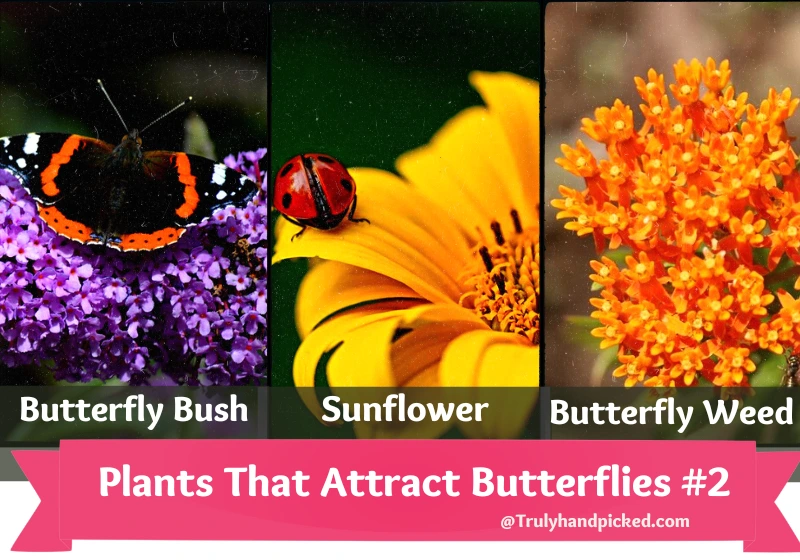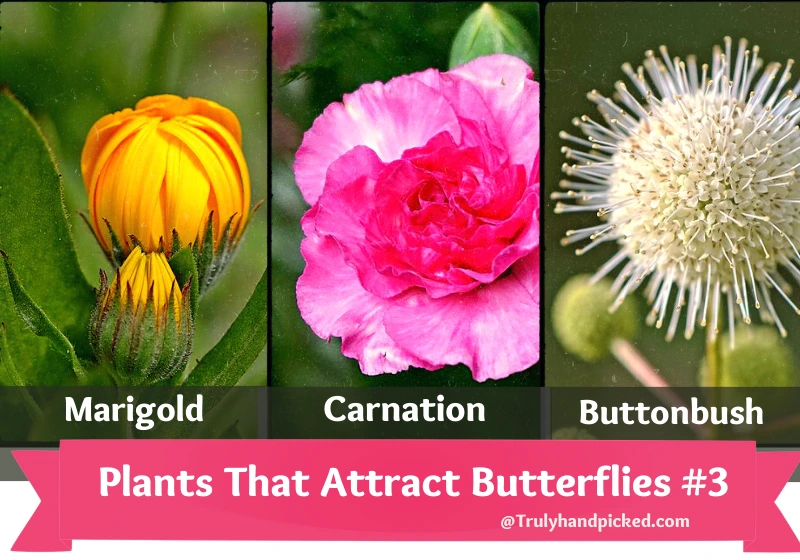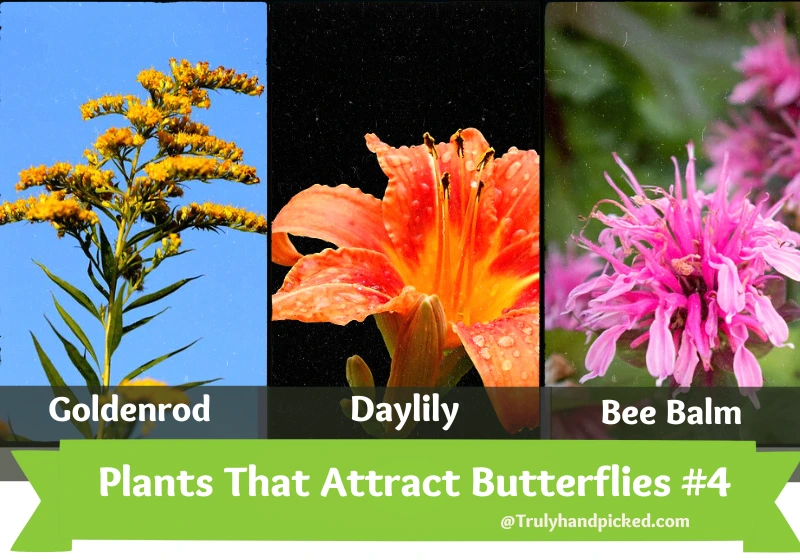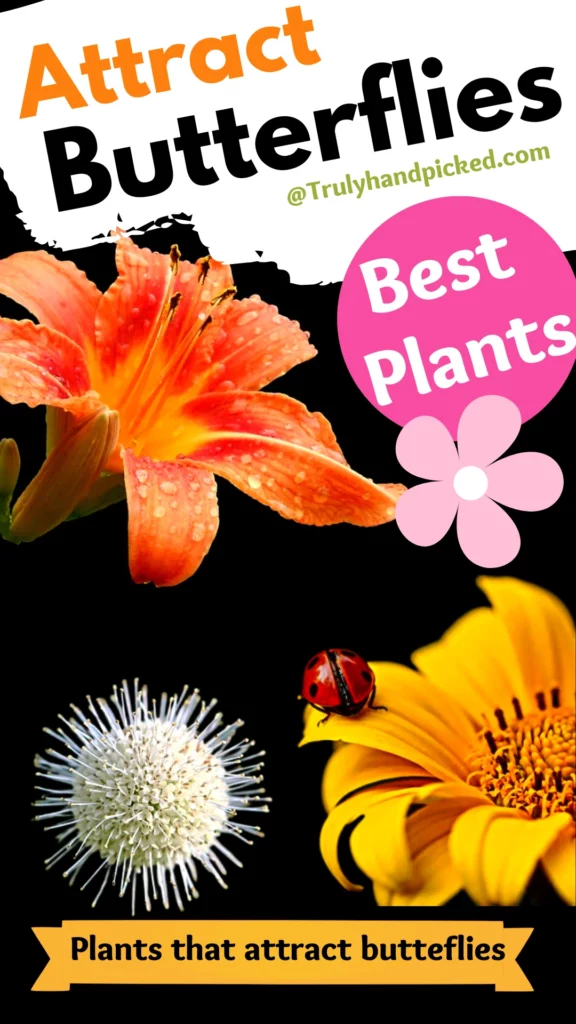Whether it is springtime, summer, or winter, butterflies always escalate the beauty of our garden amazingly. These natural pollinators give more visits to your yard when you add some alluring flowering plants to your garden.
Butterflies love flowers as they are soft and have better landing pads for them than other forms of nectar sources.
They are restricted to the liquid forms of food and flowers provide this sweet treat that binds them together for eternity.
And yes you can offer some well-ripen bananas, pineapple, melons plums, and sweet fruits as a supplement in your garden.
Also, provide water using old bowls and trays with some pebble stones here and there which can help butterflies and small insects like ladybugs to quench their thirst.
Butterflies mostly like vibrant flowers, especially those, which have nice fragrances. Add these plants to your garden area, which produce sheer radiant flowers, and see how easily you can grab the attention of this beautiful little creature to your place without any extra effort-
Attract Butterflies: What to Plant and How to Care
Candy Oh Roses:
About The Plant:
This is a beautiful species of rose category that grows in bushy plants with gorgeous red flowers. Brushy foliage can grow 3-4 feet long. They need almost an equal amount of space in width to thrive properly, due to their shaggy deciduous shrub nature.
About Flowers:
The flowers of this plant resemble magnificent in bright red shade. A flower contains 5 widely open single petals with plenty of clusters. Butterflies can sit on the flowers more easily due to their beautiful open texture.
Soil: This type of rose plant requires mildly acidic soil with well-draining quality with a pH balance between 6.1 to 6.9
Fertilizer: Use any organic fertilizer or compost to feed candy oh rose plants adequately.
Water: This plant needs regular watering, especially during the scorching summer days. After that, you can reduce the water level by watering once a week.
Climate: The plant can stand full sun for 6 hours to sunlight with partial shade for 4 hours. It can tolerate the hardiness zones from 4 to 9.
Blooming Time: Summer
Daffodils:
About The Plant:
The daffodil plant is a perennial one that produces supremely catchy blossoms. This plant belongs to the amaryllis family. Rapture daffodil species attract butterflies more than other categories. The sheathed green leaves of this species grow from a bulb and can reach 12-18 inches long at their height peak.
About Flowers:
Flowers cultivate one per stem and grow in a vibrant yellow shade and contain six petals, which are surrounded by a trumpet-shaped corona. Flowers provide a magnetic appearance to your yard when blooming in bunch among deep green foliage.
Soil: This type of daffodil likes moist but well-drained soil with a neutral pH balance between 6.9 to 7.3.
Fertilizer: Daffodil plants like moderately fertile soil to grab their proper nutrition value. Try to use liquid fish emulsion to give your plant the best thrives.
Water: The plant requires a high water level for growth, especially during germination and blooming sessions. Try to water your plant every day and then reduce it once a week, once the blooming season is gone.
Climate: The plant can stand full sun to partial shade sun with the hardiness zones 3 through 9.
Blooming Time: Late winter to early spring
Maltese Cross
About The Plant:
The Maltese cross is a wonderful garden plant to cultivate in your garden for attracting butterflies. This is an herbaceous perennial plant that belongs to the carnation family. The plant can grow 3-4 feet tall with a moderately bushy texture.
About Flowers:
Blossoms bloom in an amazing cross-shaped pattern, containing 4 to 5 petals. Petals grow in clusters with catchy red to firing orangish red shade. That pale pinkish pistol part emphasizes the vibrant flowers even more strikingly.
Soil: The plant needs loose, rich, ad evenly moist soil that has a well-drain quality. Keep the pH level between 6.1 to 6.9.
Fertilizer: Try to use a fertilizer that is rich in nitrogen and phosphorus content. Keep the ratio of NKP in your fertilizer 20-10-20 for the best result.
Water: Water your plant regularly, particularly during the starting days. Make sure you keep the soil damp constantly but not water-logged to keep your plant healthy.
Climate: The plant can tolerate full sun to sun with partial shade with the hardiness zones 3 through 10.
Blooming Time: Early to mid-summer
Butterfly Bush:
About The Plant:
This plant is probably the best one to grow in your yard to catch the attention of butterflies. Butterfly bush or Buddleja plant doesn’t need much care or attention to bloom such catchy flowers.
However, it needs a wide space to thrive as butterfly bush can grow 4-10 feet long with a wide width of 4-5 feet. The bushy green foliage emphasizes the blossom more patently.
About Flowers:
Plant mostly grows purple to pinkish violate blossoms, but sometimes produces red, white, or yellow flowers too. Flowers cultivate in spikes over deciduous shrubs.
The unavoidable beauty of butterfly bush can attract some songbirds too into your yard along with butterflies.
Soil: The plant needs a mediumly moist loose and well-drained soil type with a pH level between 6.0 to 7.0.
Fertilizer: The butterfly bush is not a high feeder thus, you don’t need to fertilize it often. Only try to use a single layer of compost after every few whiles.
Water: Plants want mediumly moist but fully drained water resistance, so water your butterfly bush plants ½ inch of water per week.
Climate: The plant can tolerate full sun exposure and at least 6-7 hours of direct sunlight to thrive best. Maintain the hardiness zones 5 through 9 to provide the plant with the perfect climate.
Blooming Time: Summer and fall
Sunflower:
About The Plant:
This is a flowering plant that belongs to the daisy family and is famous for producing catchy flowers in a vibrant shade.
Plants can grow really long around 5 to 10 and thus, must be grown in widely open garden areas to thrive best. It grows dark green leaves around flowers with rough serrated edges and scratchy texture.
About Flowers:
A sunflower pauses a unique look with quite a large head and mostly resembles a giant daisy. The brown center part emphasizes bright yellow petals.
Petals have sharp pointy edges while the pistol part contains radiating brown texture filled with seeds. Flowers always grow straight facing the sun directly and even turn their direction responsively with the sun’s movement throughout the day.
Soil: Sunflower plants like weed-free, alkaline type, and slightly acidic soil that can drain well. Keep the soil pH level between 6.0 to 7.5
Fertilizer: Nitrogen is extremely important to cultivate sunflower plants healthily. You can use organic fertilizer or poultry manure to feed this plant adequately.
Water: You need to provide an optimal level of water to fill the water requirements of sunflower plants. You can try providing enough water per day to keep the soil evenly moist but harmfully soggy.
Climate: The plant requires full sun and direct sunlight at least for 6-8 hours each day, as it grows more vigorously with more sun. the plant can tolerate the hardiness zones 2 through 11.
Blooming Time: Summer and the rainy season
Butterfly Weed:
About The Plant:
It is a must-have plant for your garden, especially if you are trying to grab attention from butterflies. This specific species of milkweed plant pauses an amazing landscaping view for its unusual flowers. Butterfly weed is a stout rough-haired perennial that can grow 24 to 36 inches tall and spread 2 to 3½ inches wide, when fully mature. Plants have a longer root system than normal flowering plants.
About Flowers:
The butterfly weed plant mostly grows orangish-yellow flowers, but sometimes it can produce red or bright yellow blossoms too.
Flowers bloom in clusters and look absolutely exotic when displayed around deep green lensed-shaped leaves. A plant takes almost three years to bloom after germination.
Soil: Butterfly plant like dry and loose soil with well-drained quality. The soil must be slightly acidic or neutral with a pH balance between 6.0 to 7.0.
Fertilizer: Try any slow-release fertilizer or organic homemade plant food to feed butterfly weeds. However, this is a low-feeder plant thus, you can skip fertilization.
Water: In the beginning, try to water your plant 1 inch per week, but you can reduce the percentage after 1 year of the plantation.
Climate: Plants need full sun to thrive and can stand the hardiness zones 4 through 9.
Blooming Time: Early to late summer
Marigold:
About The Plant:
Marigold is a beautiful flowering plant that not only keeps unwanted garden pests away but also, attracts butterflies to your yard too.
This herbaceous is a perennial that belongs to the sunflower family. Plants can grow 2-3 feet tall and spread 1-1.5 feet wide.
The leaves of this plant are pinnately divided into a leaflet, which is lanceolate and serrated. Leaves contain great medicinal properties along with a wild fragrance.
About Flowers:
Plants produce yellow, orange, red, and even maroon-colored flowers separately in the individual stem. Each flower contains multiple layers of overlapping petals. Petals get tinier and condensed toward the center like a carnation. Like a sunflower, marigold flowers mostly bloom the direct sunlight.
Soil: Plants like moderately fertile well-drained soil type with a pH balance of 7.0 to 7.5.
Fertilizer: Marigold is a lower-feeder and thus you don’t need to fertilize your plant much. Try a balanced slow-release fertilizer with a 5-10-5 NKP ratio for the best result.
Water: Water your plant only the top surface of the soil seems dry and always water the base, not over the entire plant.
Climate: Marigold needs full sun to sun with partial shade and can stand the hardiness zones 2 through 11.
Blooming Time: Winter, late spring until fall
Clove Pink/Carnation:
About The Plant:
Clove pink is an unusual garden plant that can attract many pollinators including butterflies to your garden effortlessly.
This species of dianthus plant can grow 2-3 feet tall with a slick width due to its super-slim leaves. It is a hardy perennial plant that produces glaucous leaves in the grayish-green shade with a bluish hue.
Leaves grow in egg shapes and contain a tiny length only as a calyx tube.
About Flowers:
This species of clove pink can produce blossoms in multiple colors like red white, green, blue, etc. besides pink.
Flowers grow individually in a cyme and can spread 1½-2 inches in diameter while fully grown. Clove pink flowers hold a nice clove-like fragrance and have radial symmetry along with a classy texture.
Soil: Plants like well-drained chalky soil that is little alkaline, and has a pH level between 6.6 to 7.3
Fertilizer: Use all-purpose liquid fertilizer to feed your plants with a 20-10-20 NPK ratio. You can also try any well-rotted manure to give the same nutrition to your plants.
Water: Plants require constant watering but make sure that water is draining well and you don’t make the soil water-logged.
Climate: Clove pink plants need full sun to thrive and bloom flowers. it is a hardy perennial that can stand the hardiness zones 3 to 9.
Blooming Time: Spring, summer, and fall
Buttonbush Flowers:
About The Plant:
Buttonbush is a garden plant that produces deciduous shrubs as pollen and nectar resources for several pollinators including butterflies.
The plant is a wildlife habitat but can grow in your yard with mild care and proper attention. Plants grow large foliage in deep green shades and reach almost 12 to 15 feet tall when fully grown up.
Sometimes, garden buttonbush plants only grow 6 to 8 feet long, but the flowering fraction doesn’t get hampered by this ever.
About Flowers:
The ornamental flowers of this plant are like a treat to the eyes. A buttonbush flower grows in a gumball or golf ball size in a floral sphere that is hardly 1 to 1½ inches extended in diameter.
The sphere is covered with plenty of scented tubular flowers packed closely in creamy white shade. Once the flowers are treated by pollinators, reddish-brown nutlets develop over each blossom beautifully.
Soil: This fast-growing plant needs well-drained moist soil with a pH level between 6.8 to 7.2.
Fertilizer: Use a slow-release fertilizer that is rich in nitrogen content. Apply that kind of fertilizer with a 10-5-5 NKP ratio.
Water: Water your garden buttonbush plant twice a week, and always try to keep half an inch of the topsoil wet while watering.
Climate: Plants need full sun with direct sunlight to thrive with the hardiness zones 5 through 10.
Blooming Time: From June to August
Goldenrod / Solidago:
About The Plant:
If you love to grow flowering plants with medicinal value then, goldenrod is the right pick for you. This beautiful flowering plant brings plenty of beneficial pollinators to your yard including those colorful butterflies.
It belongs to the aster family same as sunflower or marigold. It is a weed that produces catchy flowers in a vibrant yellow shade. This perennial weed generally can grow 1 to 3 feet long and equally spread in width while fully grown.
About Flowers:
Flowers bloom in a narrow pyramidal panicle as an inflorescence. Each flower is ¼ inch wide and seems like clusters when growing tightly on a lengthy rod-like stem.
The leaves of this plant have jagged edges in slick form and grow with a smooth texture. Golden-colored flowering rod displays awesome over the top of deep green leaves.
Soil: Plants need mediumly moist well-drained soil with a perfect pH level between 5.5 to 7.5
Fertilizer: This herbaceous perennial plant is a low-feeder. Try to apply organic matter in a low amount to such plants.
Water: It wants consistent damp soil but not water-logged, try watering your plant once a week for the best result.
Climate: Goldenrod plants usually crave for full sun to bloom properly, and maintain the hardiness zones between 3 to 9.
Blooming Time: Late summer to fall
Daylily:
About The Plant:
The daylily is a flowering plant that produces supremely catchy blossoms in multiple shades. This Hemerocallis genus lily plant can grow at any height from 8 inches to 5 feet, depending on the exact species.
Plants grow long and linear leaves in lanceolate or sward shapes. Plants cultivate leaves in group form at the base of the plant, while flowers bloom on the top like a situated crown of the plant.
It has a fleshy root system and is thus a short-lived type among the other lily species.
About Flowers:
Flowers of this plant grow with a long-stalked cluster in a sheer funnel or bell shape. The colors of the flowers can be varied from red to yellow but all are short-lived and thus, being called ‘day lily’.
Each flower contains three petals and three tepals. Tepals hold individual midrib in highlighted shades. The Center part of each daylily flower is emphasized by a darker shade.
Soil: Plants need a well-drained slightly acidic soil with a pH level between 6.0 to 6.5
Fertilizer: Use any organic fertilizer to feed your daylily plants properly like composted manure or kitchen waste compost. To use readymade fertilizer, apply a 5-10-5 NPK ratio for the best result.
Water: Plants need lots of water to thrive, so, water your plants every couple of days, especially at the beginning.
Climate: Your daylily plants should be planted under full sun or partial shade sun, but make sure they can grab 4 to 6 hours of sun every day.
Blooming Time: Late June through July
Bee Balm:
About The Plant:
Bee balm is a flowering plant to attract bees mostly but, you can grab the attention of little pollinators too with this one, along with butterflies.
This plant belongs to the mint family and thus grows scented leaves along with beautiful flowers. Plants can grow up to 4 feet tall and spread 3 -4 feet wide with bushy foliage.
Leaves grow in serrated shapes and arrange oppositely on the square stems.
About Flowers:
Flowers have an unusual tubular shape and form consensually symmetric, once they are fully grown. Each flower has a narrow upper side and a wide lower side. The top part of the flowers is open in a daisy-like shape with slender tubular petals. Flowers can bloom in different vibrant shades like red, pink, purple, white, etc.
Soil: Plants require a fully fertile, well-drained soil type with a pH level between 6.0 to 6.7.
Fertilizer: You can apply any balanced all-purpose fertilizer to feed your bee balm plant with a perfect 10-10-10 NPK ratio.
Water: Plants want constant moisture during the growing session, so, try to water your plants once a week and apply mulch also if possible.
Climate: Bee balm can bloom with the partial sun with indirect sunlight but also stands warm morning sun directly. It can tolerate hardiness zones 3 to 9 easily.
Blooming Time: Rainy season to late summer.




